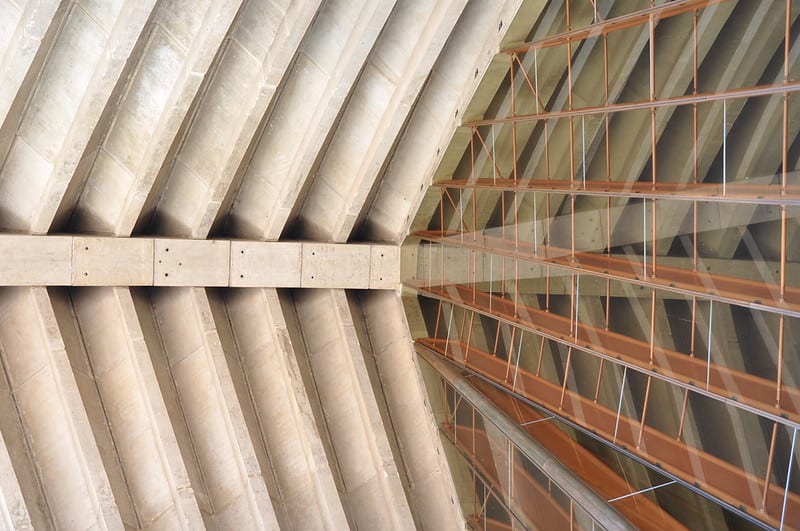One of the things that often comes up when discussing the future of construction is sustainability. The building sector is one of the largest contributors to greenhouse gas emissions (GHG), with occupied buildings being responsible for nearly 40% of global GHG emissions, according to Architecture2030.
Sourcing and manufacturing building materials also contribute a great deal to climate change. According to a report by the United Nations Environment Programme:
Some 40-50% of total flow of raw materials in the global economy is used in the manufacturing of building products and components, adding significant amounts and energy and greenhouse gas emissions to the life cycle impact of buildings. In addition, scarcity concerns over mineral resources and especially water provide for an additional urgency to extend the narrow focus on energy use in buildings and the associated greenhouse gas emissions.
The construction industry clearly has to do better to protect the environment. This is, after all, the only planet we can live in (that we know of), so promoting sustainability will serve us — and future generations.
The good news? Construction pros are already taking steps in the right direction. Builders are now exploring sustainable construction materials to replace things like concrete, which is a major source of emissions.
This post rounds up some notable examples of sustainable construction materials. Have a look and see if you can use them in your projects.
1. Bendable Concrete
Also known as Engineered Cementitious Composite (ECC), bendable concrete is a type of concrete that can withstand bending. Unlike conventional concrete, which is brittle and can easily crack or break, bendable concrete is five hundred times more resistant to cracking and is more effective at absorbing shock.
This is because ECC contains small, polymer-derived fibers that increase the material’s ductility. While bendable concrete is made up of the same ingredients as its traditional counterpart, it’s these fibers that make ECC more flexible and durable.
Bendable concrete is also more sustainable. It can be infused with carbon dioxide, which strengthens the concrete while using less cement and lowering carbon emissions.
ECC’s ductility also decreases the financial and environmental costs of buildings. Whereas traditional concrete breaks easily and typically require repairs, bendable concrete can withstand higher amounts of pressure. This means it doesn’t have to be maintained or repaired as much, so builders spend less time, resources, and carbon output when using it.
Bendable concrete has been around for decades and has proven to be durable and effective. For instance, the ECC link slab that was used to replace a conventional expansion joint on a Michigan bridge deck has lasted over 10 years without maintenance or repairs.
2. Mass Timber
Mass timber products are created by mechanically bonding various types of softwood to form large prefabricated wood components. It can come in several forms, including cross-laminated timber (CLT), laminated strand lumber (LSL), laminated veneer lumber (LVL), nail-laminated timber (NLT), and glue-laminated timber (GLT).
Mass timber has been gaining traction in the United States, and builders are increasingly using it for things like roofs, floors, beams, columns, and more.
On the sustainability side, mass timber serves as a viable substitute for traditional construction materials like steel and concrete, which have a higher carbon footprint. Using mass timber instead of conventional building materials can significantly reduce emissions.
A study published in the Journal of Building Engineering compared the environmental impact between a reinforced concrete building and a hybrid CLT commercial building and found that “an average of 26.5% reduction in the global warming potential is achieved in the hybrid CLT building compared to the concrete building, excluding biogenic carbon emissions.”
What’s more, buildings made with mass timber can be constructed faster and with less waste, further reducing the environmental impact of projects.
You can see mass timber in action at T3 (Timber, Technology, Transit), an office building in Minneapolis. The structure is built with mass timber and is designed to be a high-performing building that can “respond to Minneapolis’ ever changing climate.”
3. Salvage Materials
Reusing and recycling materials have long been key tenets of sustainability. Construction pros can apply these green principles by opting to use salvaged materials in their projects. Doing so gives construction materials a second life and helps keep waste out of landfills.
In some cases, purchasing recycled materials can also lower costs and improve the aesthetics and functionality of a building.
The Kendeda Building for Innovative Sustainable Design at Georgia Tech is one example of a project that involved salvaged materials. Skanska USA Project Manager Jimmy Mitchell used several materials to construct the building.
Jimmy recycled old slate shingles from the roof of the Georgia Tech Alumni Association building and used them on the walls and floors of the new building’s shower rooms and restrooms. He also made use of lumber from storm-felled trees on the campus, and leveraged them to make counters and benches inside the Kendeda building. Meanwhile, the heart pine joists, which were originally part of Tech Tower, were converted to threads used in the new building’s staircase.
Interested in learning more about reuse in construction? Watch this video:
[embedded content]
4. Bamboo

Another sustainable alternative to conventional construction materials, bamboo is highly flexible, allowing builders to use it for both structural and decorative purposes. It’s easy to find and source bamboo, as the tree grows in various parts of the world.
What’s more, bamboo produces very little waste. A whole stem of a bamboo tree can be used in construction, and any pieces left over are compostable, which means they naturally break down back to the earth.
The Tiing hotel in Bali used bamboo together with concrete to build textured walls that blended well with the location’s natural surroundings.
In an interview with Dezeen, hotel architect Nic Brunsdon said, “The materiality of this project aims to work within the local context, construction techniques, resources and climate – a rugged regionalism… In a tropical climate, a clean finish would require much maintenance; here, the material will weather in, enhancing the character of the architecture and place.”
5. Mycelium
The words “mushrooms” and “construction” don’t typically belong in the same sentence, but mycelium fungi may start to change that.
Mycelium is the vegetative structure of a fungus and when dried, it is highly durable and resistant to mold, water, and fire. Like bamboo, mycelium is organic and compostable, so it leaves little waste and has virtually no negative impact on the environment.
When combined with materials like timber, sawdust, and demolition waste, mycelium can be molded into bricks used for constructing buildings and their parts.
Mycelium isn’t used at a massive scale yet, but there are a few notable examples. In 2014, an organic brick structure knowns as Hy-Fi was built in Queens, New York. Created as part of MoMA’s Young Architects Program, the building used organic, biodegradable bricks made out of mycelium.
6. Precast Concrete

Precast concrete is created offsite before being transported to the job site. Unlike site cast concrete, which is poured, molded, and cured on-site, precast concrete is cured in the manufacturer’s facility and shipped to the construction site.
Precast concrete slabs are more sustainable because they take less energy and materials to produce. You can also reuse construction processes such as molds and forms, thereby reducing waste.
Some of the world’s most famous structures use this material. For instance, the shells on the roof of the Sydney Opera house are made out of precast concrete.
7. 3D Printed Concrete
3D printing can have a major impact on construction productivity and sustainability. 3D concrete printing allows you to digitally design any shape and bring — or rather print — it to life in the real world.
Unlike traditional construction, which uses up plenty of energy due to having to transport materials and go through supply chain complexities, 3D printing allows builders to design and construct faster, thus saving time, money, and energy. And because the formwork is reusable, 3D printed concrete produces less waste.
This method is being used to construct the longest 3D printed bridge in the world. Located in the city of Nijmegen in The Netherlands, the bridge is being constructed at Europe’s first industrial and commercial 3D printing factory established by Royal BAM Group nv (BAM) and materials company Saint-Gobain Weber Beamix (Saint-Gobain).
Let’s Build a More Sustainable Future
There are several paths towards sustainability and the best course of action depends on your business.
A good way to get started is to do your research. Figure out what’s right for you by exploring the different construction materials in the market and testing them in your projects.




Responses